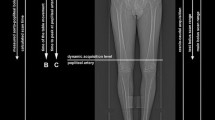Abstract
Objectives
To describe the hydrodynamic boost (HB) technique and report our preliminary results with this technique in the subintimal angioplasty of below-the-knee vessels.
Methods
HB was used in 23 cases (14 males, mean age 73 ± 12 years) of critical limb ischemia, with long chronic total occlusion of tibial arteries extended to the ankle level. The operator performs a manual injection of diluted contrast dye through a 4 F catheter into the subintimal space, close to the patent true distal lumen, in order to achieve a tear in the intimal flap and a connection with the true lumen.
Results
In 19/23 (83 %) cases, the HB was effective in creating a connection between the subintimal space and the true distal lumen and it was possible to advance a wire and to conclude the procedure. In 4/23 (17 %) lesions, the HB failed and the procedure was successfully completed by retrograde approach. No major complications occurred. Mean length between catheter tip and re-entry point was 8 ± 5 mm.
Conclusions
HB seems to be a feasible, safe and effective re-entry technique in distal below-the-knee vessels. This method represents an easy option for re-entry that extends the possibility of antegrade approach to obtain a successful revascularization.
Key points
• In subintimal angioplasty of below-the-knee vessel re-entry can represent a challenge.
• Inability to re-enter may determine the failure of the revascularization procedure.
• HB is a novel re-entry technique feasible in distal below-the-knee vessels.
• HB may increase the success rate of antegrade approach.
• In case of failure, retrograde approach remains feasible.






Similar content being viewed by others
References
Bown MJ, Bolia A, Sutton AJ (2009) Subintimal angioplasty: meta-analytical evidence of clinical utility. Eur J Vasc Endovasc Surg 38:323–337
Met R, Van Lienden KP, Koelemay MJW, Bipat S, Legemate DA, Reekers JA (2008) Subintimal angioplasty for peripheral arterial occlusive disease: a systematic review. Cardiovasc Intervent Radiol 31:687–697
Vraux H, Bertoncello N (2006) Subintimal angioplasty of tibial vessel occlusions in critical limb ischaemia: a good opportunity? Eur J Vasc Endovasc Surg 32:663–667
Vraux H, Hammer F, Verhelst R, Goffette P, Vandeleene B (2000) Subintimal angioplasty of tibial vessel occlusions in the treatment of critical limb ischaemia: mid-term results. Eur J Vasc Endovasc Surg 20:441–446
Bolia A (1998) Percutaneous intentional extraluminal (subintimal) recanalization of crural arteries. Eur J Radiol 28:199–204
Zhu Y-Q, Zhao J-G, Liu F et al (2009) Subintimal angioplasty for below-the-ankle arterial occlusions in diabetic patients with chronic critical limb ischemia. J Endovasc Ther 16:604–612
Nydahl S, Hartshorne T, Bell PR, Bolia A, London NJ (1997) Subintimal angioplasty of infrapopliteal occlusions in critically ischaemic limbs. Eur J Vasc Endovasc Surg 14:212–216
Varty K, Bolia A, Naylor AR, Bell PR, London NJ (1995) Infrapopliteal percutaneous transluminal angioplasty: a safe and successful procedure. Eur J Vasc Endovasc Surg 9:341–345
Bolia A, Miles KA, Brennan J, Bell PR (1990) Percutaneous transluminal angioplasty of occlusions of the femoral and popliteal arteries by subintimal dissection. Cardiovasc Intervent Radiol 13:357–363
Hynes N, Akhtar Y, Manning B et al (2004) Subintimal angioplasty as a primary modality in the management of critical limb ischemia: comparison to bypass grafting for aortoiliac and femoropopliteal occlusive disease. J Endovasc Ther 11:460–47111
Hausegger KA, Georgieva B, Portugaller H, Tauss J, Stark G (2004) The outback catheter: a new device for true lumen re-entry after dissection during recanalization of arterial occlusions. Cardiovasc Intervent Radiol 27:26–30
Schneider PA, Caps MT, Nelken N (2013) Re-entry into the true lumen from the subintimal space. J Vasc Surg 58:529–534
Airoldi F, Faglia E, Losa S et al (2011) A novel device for true lumen re-entry after subintimal recanalization of superficial femoral arteries: first-in-man experience and technical description. Cardiovasc Intervent Radiol 34:166–169
Ferraresi R, Palena LM, Mauri G, Manzi M (2013) Tips and tricks for a correct ‘endo approach’. J Cardiovasc Surg (Torino) 54:685–711
Manzi M, Palena LM (2013) Retrograde percutaneous transmetatarsal artery access: new approach for extreme revascularization in challenging cases of critical limb ischemia. Cardiovasc Intervent Radiol 36:554–557
Manzi M, Palena L, Cester G (2011) Endovascular techniques for limb salvage in diabetics with crural and pedal disease. J Cardiovasc Surg (Torino) 52:485–492
Spinosa DJ, Harthun NL, Bissonette EA et al (2005) Subintimal arterial flossing with antegrade-retrograde intervention (SAFARI) for subintimal recanalization to treat chronic critical limb ischemia. J Vasc Interv Radiol 16:37–44
Zhu Y-Q, Zhao J-G, Li M-H et al (2010) Retrograde transdorsal-to-plantar or transplantar-to-dorsal intraluminal re-entry following unsuccessful subintimal angioplasty for below-the-ankle arterial occlusion. J Endovasc Ther 17:712–721
Carlino M, Godino C, Latib A, Moses JW, Colombo A (2008) Subintimal tracking and re-entry technique with contrast guidance: a safer approach. Catheter Cardiovasc Interv 72:790–796
Taylor RS (1967) Gas endarterectomy. Techniques, applications, and initial results. Lancet 2:281–283
Kaplitt MJ, Sobel S, Sawyer PN (1967) Review of femoral-popliteal reconstruction utilizing gas endarterectomy. Surgery 62:872–883
Blaisdell FW, Hall AD, Thomas AN (1966) Surgical treatment of chronic internal carotid artery occlusion by saline endarterectomy. Ann Surg 163:103–111
Acknowledgements
The scientific guarantor of this publication is Roberto Ferraresi. The authors of this manuscript declare no relationships with any companies, whose products or services may be related to the subject matter of the article. The authors state that this work has not received any funding. No complex statistical methods were necessary for this paper. Institutional Review Board approval was obtained. Written informed consent was obtained from all subjects (patients) in this study. Methodology: retrospective, observational, performed at one institution.
Author information
Authors and Affiliations
Corresponding author
Rights and permissions
About this article
Cite this article
Ferraresi, R., Hamade, M., Gallicchio, V. et al. Hydrodynamic boost: a novel re-entry technique in subintimal angioplasty of below-the-knee vessels. Eur Radiol 26, 2419–2425 (2016). https://doi.org/10.1007/s00330-015-4078-4
Received:
Revised:
Accepted:
Published:
Issue Date:
DOI: https://doi.org/10.1007/s00330-015-4078-4




